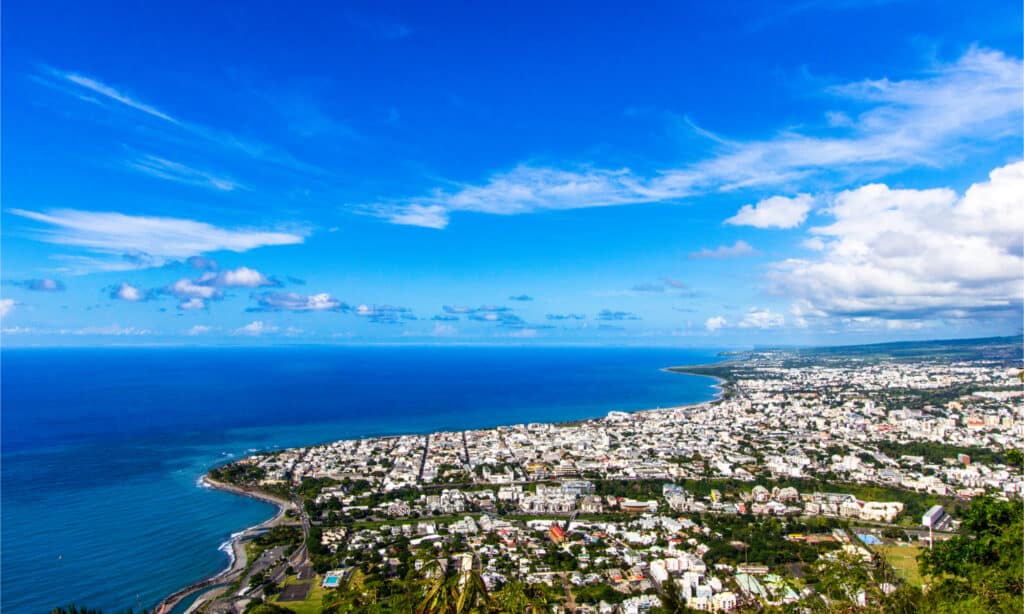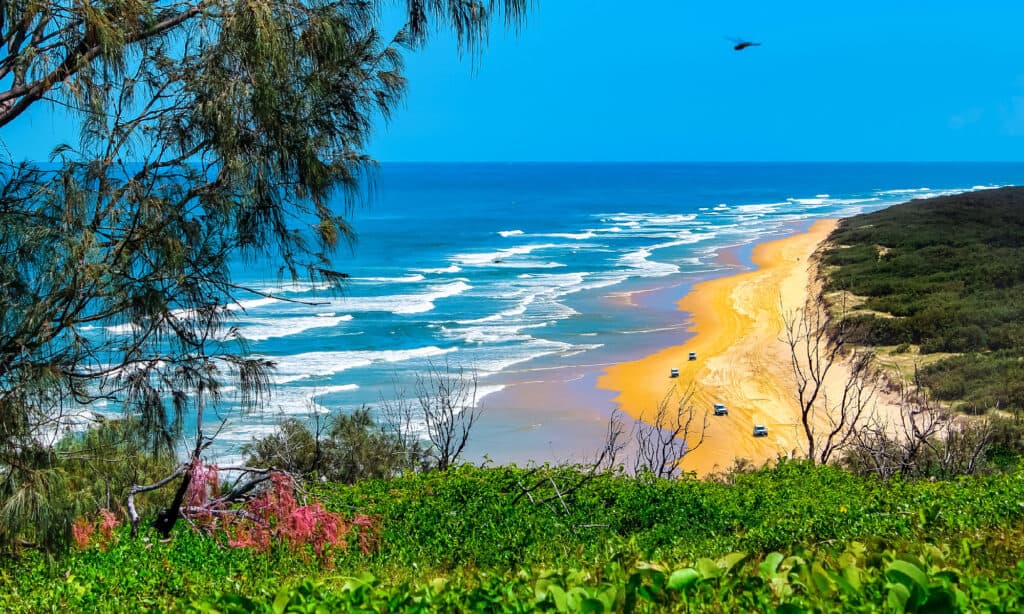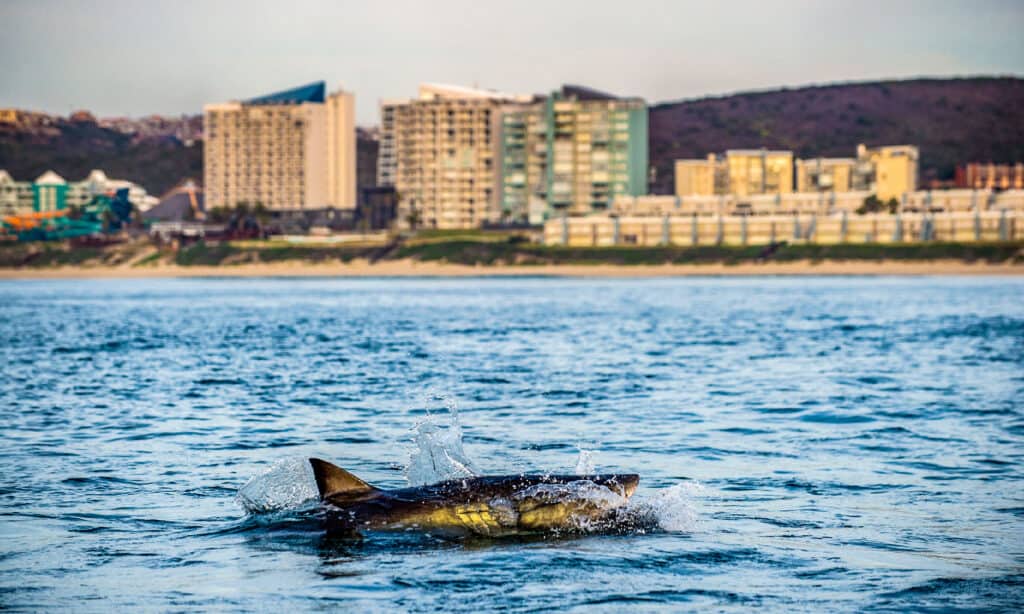Many people fear sharks, and for a good reason. The great white shark is the largest predatory shark in the world, weighs up to 5000 pounds, and measures 20 feet long. This shark is known to be aggressive to humans and can be found close to shorelines.
Sharks hunt on the ocean floor and are known to swim closer to the shoreline for fish. With the rise in water recreational activities on beaches around the world, shark attacks have increased in recent years.
Let’s discuss places with the most shark attacks in the world.
4 Places with the Most Shark Attacks in the World

Between 1913 and 2018, there have been 56 shark attacks, with 27 being fatal on Reunion Island.
©julienjanusko/Shutterstock.com
In recent years, Reunion Island has been known as the island with the most shark attacks in recent years, with 27 recorded fatal attacks since 1913. While the island is duly feared for its shark-infested waters, there are places around the world with more shark attacks. Let us get right into the top four places with the most shark attacks.
1. The United States of America

There have been 1,563 recorded shark attacks off the coast of the United States of America.
©Urban Images/Shutterstock.com
The United States of America represents more than 50% of the North American continent’s population. It is the 4th largest country in the world and the 3rd most populous. The North American country, which spans 3,796,742 square miles (9,833,520 square kilometers) of land and shoreline, is known for its many beaches and for being the country with the most shark attacks in the world.
Based on statistics from the University of Florida’s International Shark Attack File, there have been 1,563 shark attacks in America between 1580 and 2022. In the State of Florida alone, there have been 603 recorded shark attacks since 1959.
Due to America’s access to the Pacific and Atlantic oceans, there are many shark sightings off the shoreline of America. The common sharks along America’s shorelines are the great white shark, whale shark, lemon shark, Atlantic sharpnose, spiny dogfish, smooth hammerhead, spinner, and blacktip shark.
2. Australia

There have been 682 recorded attacks in Australia.
©iStock.com/wWeiss Lichtspiele
Australia is both a country and a continent. It is made up of a large landmass, measuring 2,941,300 square miles (7,617,930 square kilometers), and many islands. Australia is located between the Pacific, Southern, and Indian oceans. Its diverse ecosystem and coral reefs make the shorelines off the continent appealing to sharks for hunting and birthing their young.
There have been 682 unprovoked shark attacks around Australia since 1580. According to Taronga Conservation Society Australia, between 2012 and 2021, there have been 143 shark attack bites, with 20 fatal. The state of New South Wales has had the most shark attacks on the continent, with 267 attacks recorded.
Australia is home to 180 shark species, forcing some of its waters to be closed to curb attacks on humans. Some commonly sighted sharks in the region include the scalloped hammerhead shark, manta rays, silky shark, porbeagle shark, oceanic whitetip shark, smooth hammerhead shark, and largetooth sawfish.
3. South Africa

There have been 258 recorded shark attacks in South
Africa
.
©iStock.com/USO
South Africa is the southernmost country in Africa and has a coastline that stretches 1,739 miles (2,798 kilometers). It is also bounded by the Indian and the South Atlantic oceans. The African country has one of the richest biodiversity in Africa but is also known for its shark attacks. Between 1580 and now, there have been 258 recorded shark attacks, with about 42% in Eastern Cape.
Bordered by two oceans, it is not shocking that about 15% of the world’s marine ecosystem is found in the country’s waters. Another factor that influences the heavy presence of sharks along South Africa’s coastlines is the proximity to the shark Alley. This strip of the sea between Geyser Rock and Dyer Island is home to thousands of seals which are food sources for sharks, especially great white sharks.
Other commonly sighted sharks along the coast of South Africa include the dusky shark, kitefin shark, pyjama shark, Zambezi shark, tiger shark, whale shark, and ragged-tooth shark.
4. Brazil

There have been 110 recorded shark attacks in Brazil
©iStock.com/marchello74
Brazil is the largest country in South America. The country is bounded by the Atlantic Ocean in the east, with its coastline measuring 4,655 miles (7,491 kilometers), the largest on the continent. While the South American country is majorly known to be dangerous for its venomous snakes, its coastlines have been plagued by shark attacks for years.
According to the ISAF, there have been 110 unprovoked shark attacks in the region. The Brazilian state most notorious for shark attacks is Pernambuco, and other places in the country with frequent shark attacks are Recife and Fernando de Noronha.
Of the numerous shark species that tread Brazilian waters, the bull shark and tiger shark are the most renowned for attacks on humans. Other shark species around Brazil are blue shark, whale shark, shortfin mako shark, hammerhead shark, blacktip shark, great white shark, and thresher shark.
What are the Odds of Getting Bitten in these Regions of the World?
The likelihood of getting a shark bite is extremely low, and the odds of fatality are even lower. According to the ISAF, shark bites and attacks on humans occur an average of 70 times a year and cause about 5 fatalities. These odds mean that many people might never even encounter a shark throughout their lives, much less get bitten by one. A person is more likely to die from a lightning strike, ocean currents, bee stings, dog bites, and alligator attacks than they would from a shark bite.
Why Do Sharks Attack?
Most sharks do not feed on humans and most shark bites are termed “accidents.” Shark attacks occur annually because of increased human interactions. There are more people in the sea and oceans these days.
Sharks can swim closer to shore, mistaking a human for a fish until they get closer. The more aggressive shark species are the bull shark, tiger shark, sand shark, and great white shark.
Ways to Reduce Risks of Shark Attack
While the odds of getting attacked by a shark are quite small, caution must still be taken when entering the water, which is the shark’s natural habitat. There are many ways to reduce the risk of shark attacks. Some of these ways, according to the International Shark Attack File, include the following:
- Keep away from shark-infested waters.
- Avoid wearing shiny ornaments that could be mistaken for fish scales in water.
- Avoid entering the ocean in low light hours.
- Do not swim alone, as sharks are more likely to attack a lone figure in the water.
- Refrain from excessive splashing about in the water so as not to draw sharks who might mistake you for a fish.
- Avoid wearing contrasting colors in the water, as sharks will quickly notice.
- Do not enter waters known to have sharks with cuts or wound openings.
The photo featured at the top of this post is © Michael Rothschild/Shutterstock.com
Thank you for reading! Have some feedback for us? Contact the AZ Animals editorial team.






